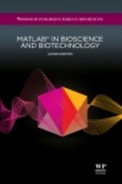Preface
In the last few decades, two seemingly disparate sciences – computer science and biology – have interpenetrated and affected one another. We see students enrolled in computer science beginning their careers in biotechnological laboratories, and biotechnologists creating bio-computers and being active in computer science. There appears to be an urgent need to familiarize biotechnologists with the same computing tools as are imparted to technicians.
This book represents a short introduction to MATLAB® oriented towards various collaborative areas of biotechnology and bioscience. My hope is that it will be equally useful to undergraduate and graduate students and to practising engineers. It concentrates on the fundamentals of MATLAB® and gives examples of its application to a wide range of current bioengineering problems in computational biology, molecular biology, biokinetics, biomedicine, bioinformatics and biotechnology. In the last decade MATLAB® has been presented to students as a basic computational tool that they need to learn. Consequently, many students unfamiliar with programming, engineers and scientists have come to regard it as user-friendly and highly convenient in solving their specific problems. Numerous books are available on programming in MATLAB® for engineers in general, irrespective of their specialization, or for those specializing in some specific area, but none has been designed specifically for a wide, interdisciplinary, topical area such as bioengineering. Thus, MATLAB® is presented here with examples and applications to various school- and advanced bioengineering problems – from growing populations of microorganisms and population dynamics, to reaction kinetics and reagent concentrations, predator–prey models, mass- transfer problems, and to sequence analysis and sequence statistics.
The book distills my experience of many years of MATLAB® teaching in introductory and advanced courses for students, engineers and scientists specializing in bioscience and engineering.
I would like to thank the people who attracted me to the subject and thereby played key roles in the inception and appearance of this book: my colleague Professor Rosa Azhari (Biotechnology Department, ORT Braude College), and software support team head Moshe Barak (Computer Center, Technion – Israel Institute of Technology). I also thank MathWorks Inc. (3 Apple Hill Drive, Natick, MA 01760–2098, USA, Tel: 508-647-7000, Fax: 508-647-7001, E-mail: [email protected], Web: www.mathworks.com) who graciously granted permission to reproduce material appearing in this book.
I thank Ing. Eliezer Goldberg, former resident scientific editor at Technion, for patience and invaluable editorial assistance, and would also like to thank Dr Glyn Jones, head of Biohealthcare Publishing (Oxford) Ltd, for invaluable support throughout all stages of publication of this book.
I hope this book will prove useful to students and engineers in both natural and life sciences and provide them with an opportunity to work with one of the finest software tools.
Any reports of errata or bugs, comments and suggestions on the book’s contents will be accepted gratefully by the author.
